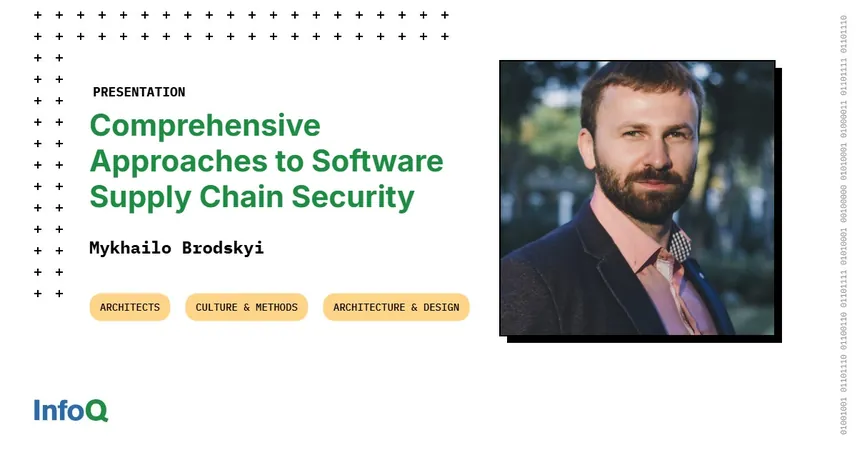
Unlocking Software Supply Chain Security: Vital Strategies for the FinTech World
2025-04-09
Author: Amelia
In the ever-evolving FinTech landscape, software supply chain security stands as a monumental challenge. Mykhailo Brodskyi, a Principal Software Architect, sheds light on this critical area, aiming to arm organizations with the knowledge to effectively mitigate security risks.
Understanding FinTech Challenges
Brodskyi begins with the unique hurdles faced in the FinTech sector, particularly around customer onboarding and payment processing. These core business domains are rife with applications that cater to various regulatory standards, such as PSD2 for payment processing and AMLD for fraud detection. The complexity of these regulations amplifies the inherent risks, necessitating robust security frameworks.
Demystifying the Software Supply Chain
Transitioning to the software supply chain, Brodskyi draws a parallel to traditional physical goods supply chains. While raw materials flow from suppliers to manufacturers and eventually to customers, software development similarly relies on third-party libraries and dependencies. Any breach or compromise anywhere in this chain can jeopardize the entire product.
Threats Lurking in Third-Party Libraries
Brodskyi emphasizes the vital need for third-party libraries to be certified. Employing Software Composition Analysis (SCA) is a key strategy to detect vulnerabilities through dependency and license checks. This allows organizations to maintain proactive oversight of their development pipelines, ensuring continuous monitoring and security.
Securing Internal Development Processes
For internal development, adhering to industry standards like PCI DSS is crucial. This framework provides guidelines for securing cardholder data and sets the stage for thorough infrastructure analysis, segmentation strategies, and ongoing monitoring—all vital for maintaining security integrity.
Learning from Real-World Case Studies
Brodskyi shares a compelling case study from a migration project where a company transitioned over 100 applications from a private data center to the cloud. This undertaking not only demanded a review of segmentation strategies but also the creation of a more resilient architecture, ensuring that payment processing components and data segmentation were rigorously managed.
Mitigating Risks in Delivery and Governance
As software progresses through various deployment stages, risks such as exposed credentials and insecure artifacts arise. Implementing robust secret management tools and conducting static/dynamic security testing can safeguard against these vulnerabilities. Continuous integration of security protocols is essential to mitigate risks effectively.
Hands-On Demonstration: From Concept to Execution
During a recent demo, Brodskyi illustrated how a simple microservice in GitHub could leverage a Software Bill of Materials for thorough analysis and verification. He showcased how easy it is to integrate security scans within the pipelining process, allowing teams to pinpoint vulnerabilities efficiently.
Navigating the Future of Compliance and Security
As the conversation shifted to compliance, Brodskyi addressed the burgeoning DORA regulations aimed at enhancing resilience within the FinTech industry. He underscored the significance of adapting current security measures not just in response to regulations but as a part of an overall strategy to enhance infrastructure resilience.
Join the Fight for Software Supply Chain Security!
The challenges in securing the software supply chain in the FinTech sector are daunting, yet by employing stringent compliance measures, thorough analysis, and ongoing education, organizations can build a fortress around their digital assets. Brodskyi’s insights serve as a clarion call for industry professionals to take proactive steps in safeguarding their operations.









 Brasil (PT)
Brasil (PT)
 Canada (EN)
Canada (EN)
 Chile (ES)
Chile (ES)
 Česko (CS)
Česko (CS)
 대한민국 (KO)
대한민국 (KO)
 España (ES)
España (ES)
 France (FR)
France (FR)
 Hong Kong (EN)
Hong Kong (EN)
 Italia (IT)
Italia (IT)
 日本 (JA)
日本 (JA)
 Magyarország (HU)
Magyarország (HU)
 Norge (NO)
Norge (NO)
 Polska (PL)
Polska (PL)
 Schweiz (DE)
Schweiz (DE)
 Singapore (EN)
Singapore (EN)
 Sverige (SV)
Sverige (SV)
 Suomi (FI)
Suomi (FI)
 Türkiye (TR)
Türkiye (TR)
 الإمارات العربية المتحدة (AR)
الإمارات العربية المتحدة (AR)